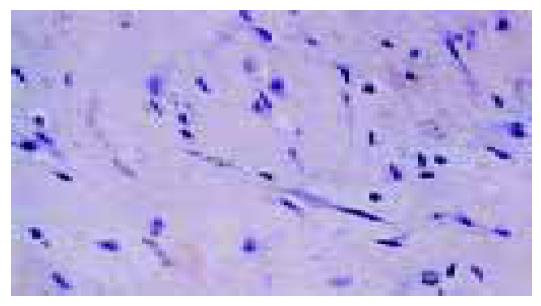INTRODUCTION
Gastrointestinal stromal tumors (GIST) include a variety of primary mesenchymal tumors of the gastrointestinal tract such as leiomyoma, leiomyosarcoma, leiomyoblastoma, and schwannoma[1]. They have recently been distinguished from each other on the basis of the tumor cell differentiation revealed by immunohistochemical studies[2,3]. Besides the above-mentioned pathologies, the term GIST has been recently applied to mesenchymal tumors that represent neither typical leiomyoma nor schwannoma[2,4].
It is well established that schwannomas appear more frequently in the stomach and the small intestine, while location in the colon or in the rectum is uncommon[5,6]. Most of them are benign and asymptomatic; nevertheless, the possibility of malignant degeneration does exist and is directly related to the tumor dimensions. Radical surgical treatment is the gold standard in all cases, since the results of both chemotherapy and radiotherapy remain uncertain[7].
CASE REPORT
A 55-year-old male patient was admitted to our department, with a chief complaint of intermittent rectal bleeding and diarrhea that had started 2 mo before admission. Physical findings and digital examination were undiagnostic, but laboratory tests disclosed red blood cell count: 3.2×105/mm3, hemoglobin: 74 g/L, and hematocrit: 26.4%. Colonoscopy revealed a wide-based mass protruding from the posterior wall of sigmoid and multiple biopsies were taken from different parts of the tumor. Abdominal x-rays were negative for bowel obstruction, while CT scans proved no metastatic disease. Additionally, the serum levels of tumor markers including carcinoembryonic antigen and Ca 19-9 were within normal ranges. The diagnosis of schwannoma Antoni B type was set preoperatively based on the endoscopic biopsies and intraoperatively, segmental resection of the tumor with wide margins was performed (Figures 1A and B). Permanent sections with H&E confirmed the preoperative diagnosis (Figure 2). The patient recovered uneventfully and at 5 years following surgery, he was free of disease without receiving adjuvant therapy.
Figure 1 Macroscopic view of the sigmoid colon showed a well-circumscribed submucosal tumor (A).
The cut surface of this tumor consisted of fibrotic and myxoid parts and was gray-yellowish in color (B).
Figure 2 Microscopic view of a benign schwannoma (H&E×40).
Compact spindle cells arranged in short bundles are seen.
DISCUSSION
Schwannomas are mainly benign tumors derived from the cells of Schwann that form the neural sheath, which may become malignant, if left untreated[8-10]. They can be located everywhere, but the most common type of benign schwannoma is the acoustic neuroma (VIII cranial nerve)[11].
Malignant schwannomas usually come under the heading of soft tissue sarcomas and the gastrointestinal tract is one of the sites that such tumors can be found[12]. In these cases they constitute together with leiomyoma, leiomyosarcoma, leiomyoblastoma, and another type with mixed characteristics between leiomyoma and schwannoma, the GIST[13]. All of these primary mesenchymal tumors show a wide range of common histological and immunohistochemical characteristics[2,14].
Peripheral nerve sheath tumors represent 2-6% of stromal tumors of the gastrointestinal tract[3,4] but reports of solitary schwannomas of the rectum and colon are even more rare[15]. They have almost the same incidence in men and women and a median age of presentation, 65 years of age[4]. Their size may vary; a case of a rectal schwannoma with a diameter of 8 cm which was primarily misdiagnosed as a myogenic sarcoma has been reported[2,5].
Although, they usually grow very slowly and are asymptomatic, sometimes they may cause rectal bleeding, colonic obstruction, defecation disorders, and pain[3,4]. It is very important to emphasize that rectal pain can also be the only symptom of intraspinal schwannomas which they often mislead the diagnosis to proctalgia fugax or rectal neuralgia[15].
Two histologic types of schwannomas have been described; Antoni type A with densely packed spindle cells (Verocay bodies) and Antoni type B with loosely organized spindle cells (absence of Verocay bodies) in myxoid stroma[3,4]. Imm-unology plays a central role to the diagnosis of schwannoma as in many other types of cancer[16]. Strongly positive S-100 protein, low affinity, nerve growth factor receptor (P75), collagen IV, GFAP, CD34, and negative CD117, neurof-ilament protein, smooth muscle actin, and desmin, turn out to be supportive to the diagnosis of the benign tumor as a schwannoma[2,3,12]. Schwannomas may also appear in patients with Von Recklinghausen disease (NF I), although there is no evident connection between colorectal schwannomas and NF I[17].
Radical excision with margins free of disease is the treatment of choice, since their response to both chemotherapy and radiotherapy remain uncertain[4,18]. Nevertheless, despite aggressive surgical management, these tumors appear with a high rate of local recurrence and malignant degeneration. In such case’s the treatment options are few and the prognosis is poor[3,7,8].
The surgical approach depends on the tumor size and histologic features that mainly determine the prognosis. Preoperative imaging tests including abdominal x-rays, transanal 3D-ECHO, MRI, and CT scans can be very useful in the selection of patients for surgical treatment[19]. Besides the commonly used surgical techniques, minimally invasive modalities can be performed too. In the transanal endoscopic microsurgery (TEM), the local excision is accomplished through a rectal expander[20,21] with or without the use of an ultrasonically activated scalpel[22]. Alternatively, in cases of the benign schwannomas located on the distal parts of the rectum, a transanal resection can be performed followed by recto-anal anastomosis[21].
In conclusion, rectal schwannoma is a very rare tumor, whose diagnostic approach and treatment present certain gray areas. Nevertheless, it has become obvious that the preoperative histological identification of the tumor followed by a radical surgical resection is the cornerstone, which will determine the overall outcome.










